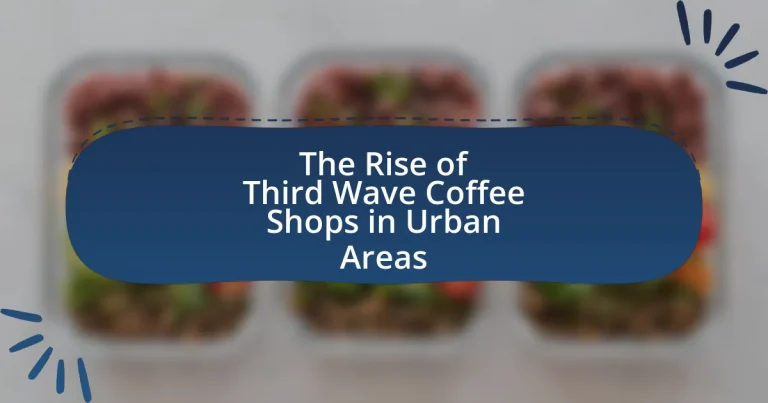Third Wave Coffee Shops represent a movement that prioritizes high-quality, artisanal coffee, emphasizing ethical sourcing and meticulous brewing techniques. This article explores the characteristics that distinguish Third Wave Coffee from previous coffee movements, highlighting its focus on sustainability, direct trade relationships with farmers, and the unique flavor profiles of coffee beans. It also examines the cultural impact of these shops in urban areas, their influence on local communities, and the challenges they face, including competition and operational costs. Additionally, the article discusses strategies for success, including effective marketing and customer loyalty initiatives, which are essential for thriving in the competitive urban coffee market.

What are Third Wave Coffee Shops?
Third Wave Coffee Shops are establishments that emphasize high-quality coffee, artisanal brewing methods, and a focus on the unique characteristics of coffee beans. This movement, which began in the early 2000s, seeks to elevate coffee from a commodity to a craft, similar to wine. Third Wave Coffee Shops often source their beans directly from farmers, ensuring fair trade practices and highlighting the distinct flavors of different coffee-growing regions. The emphasis on transparency in sourcing and preparation methods is a hallmark of this wave, with many shops providing detailed information about the origin of their coffee and the brewing techniques used.
How do Third Wave Coffee Shops differ from previous coffee movements?
Third Wave Coffee Shops differ from previous coffee movements by emphasizing quality, sustainability, and the unique characteristics of coffee as a craft beverage. Unlike First Wave coffee, which focused on mass production and convenience, and Second Wave coffee, which introduced specialty coffee and café culture, Third Wave coffee prioritizes direct trade relationships with farmers, meticulous brewing methods, and a deep appreciation for the origin and flavor profiles of coffee beans. This movement has led to a significant increase in consumer awareness regarding the sourcing and preparation of coffee, with many Third Wave shops offering single-origin brews and detailed tasting notes, reflecting a shift towards artisanal practices in the coffee industry.
What defines the characteristics of Third Wave Coffee?
Third Wave Coffee is characterized by a focus on high-quality, artisanal coffee that emphasizes transparency in sourcing, meticulous brewing techniques, and a deep appreciation for the flavor profiles of different coffee beans. This movement prioritizes direct trade relationships with coffee farmers, ensuring fair compensation and sustainable practices, which enhances the quality of the beans. Additionally, Third Wave Coffee shops often feature single-origin coffees, specialty brewing methods such as pour-over and siphon, and a commitment to educating consumers about the nuances of coffee tasting. This approach has been validated by the increasing consumer demand for premium coffee experiences, as evidenced by the growth of specialty coffee sales, which reached over $45 billion in the U.S. in 2022, reflecting a shift towards quality over quantity in coffee consumption.
Why is the sourcing of coffee beans important in Third Wave Coffee Shops?
The sourcing of coffee beans is crucial in Third Wave Coffee Shops because it directly impacts the quality, flavor, and sustainability of the coffee served. Third Wave Coffee emphasizes transparency and traceability, often sourcing beans from specific farms or regions known for unique flavor profiles, which enhances the overall coffee experience. For instance, many Third Wave shops prioritize direct trade relationships with farmers, ensuring fair compensation and promoting sustainable farming practices, which can lead to higher quality beans. This approach not only supports ethical consumption but also allows consumers to appreciate the distinct characteristics of coffee from different origins, aligning with the movement’s focus on artisanal craftsmanship and quality.
What cultural impact do Third Wave Coffee Shops have in urban areas?
Third Wave Coffee Shops significantly influence urban culture by promoting artisanal coffee practices and fostering community engagement. These establishments prioritize quality, sustainability, and transparency in sourcing, which cultivates a culture of appreciation for coffee as a craft rather than a commodity. Research indicates that Third Wave Coffee Shops often serve as social hubs, enhancing local economies and encouraging social interactions among diverse groups. For instance, a study by the Specialty Coffee Association highlights that these coffee shops contribute to urban revitalization by attracting foot traffic and supporting local artists and events, thereby enriching the cultural fabric of urban areas.
How do Third Wave Coffee Shops influence local communities?
Third Wave Coffee Shops influence local communities by fostering social interaction, supporting local economies, and promoting sustainable practices. These establishments often serve as community hubs where individuals gather, enhancing social cohesion and providing a space for cultural exchange. According to a study by the Specialty Coffee Association, Third Wave Coffee Shops contribute significantly to local economies by sourcing coffee beans from local roasters and employing local staff, which circulates money within the community. Additionally, many of these shops prioritize sustainability by implementing eco-friendly practices, such as using ethically sourced coffee and reducing waste, which encourages community awareness and participation in environmental initiatives.
What role do Third Wave Coffee Shops play in the urban lifestyle?
Third Wave Coffee Shops serve as cultural hubs in urban lifestyles, fostering community engagement and social interaction. These establishments prioritize high-quality coffee sourced from sustainable practices, appealing to a growing demographic that values artisanal products and ethical consumption. Research indicates that Third Wave Coffee Shops often become gathering spaces for diverse groups, enhancing local economies and promoting social cohesion. For instance, a study by the Specialty Coffee Association highlights that these coffee shops contribute to urban revitalization by attracting foot traffic and supporting local artists and events, thereby enriching the urban experience.

Why is there a rise of Third Wave Coffee Shops in urban areas?
The rise of Third Wave Coffee Shops in urban areas is primarily driven by a growing consumer demand for high-quality, artisanal coffee experiences. Urban populations increasingly prioritize specialty coffee that emphasizes sourcing, brewing techniques, and unique flavor profiles, reflecting a broader trend towards gourmet food and beverage consumption. According to a report by the Specialty Coffee Association, the specialty coffee market has seen consistent growth, with consumers willing to pay a premium for ethically sourced and expertly crafted coffee. This shift in consumer preferences, combined with the urban lifestyle that values unique and experiential dining options, has led to the proliferation of Third Wave Coffee Shops in cities.
What factors contribute to the popularity of Third Wave Coffee Shops in cities?
The popularity of Third Wave Coffee Shops in cities is primarily driven by a focus on high-quality coffee, artisanal brewing methods, and a strong emphasis on sustainability. These shops prioritize sourcing beans from specific regions, often emphasizing direct trade relationships with farmers, which appeals to consumers’ growing interest in ethical consumption. Additionally, the unique and inviting atmosphere of Third Wave Coffee Shops fosters community engagement and social interaction, making them desirable gathering spaces. According to a report by the Specialty Coffee Association, the demand for specialty coffee has increased significantly, with consumers willing to pay a premium for quality and experience, further solidifying the popularity of these establishments in urban areas.
How does urbanization affect coffee consumption trends?
Urbanization significantly increases coffee consumption trends by fostering a culture that values specialty coffee and convenience. As urban areas grow, populations become more concentrated, leading to a higher demand for coffee shops that offer unique, high-quality coffee experiences. According to a report by the Specialty Coffee Association, urban consumers are more likely to seek out artisanal coffee options, contributing to the rise of third wave coffee shops that emphasize quality, sustainability, and direct trade. This shift is evidenced by the growth of coffee shop density in metropolitan areas, where the number of specialty coffee shops has increased by over 30% in the last decade, reflecting changing consumer preferences driven by urban lifestyles.
What demographic shifts are driving the demand for Third Wave Coffee?
The demand for Third Wave Coffee is primarily driven by the increasing preferences of millennials and Gen Z consumers for high-quality, artisanal products. These demographic groups prioritize sustainability, ethical sourcing, and unique flavor experiences, which are hallmarks of Third Wave Coffee. According to a 2021 report by the Specialty Coffee Association, 60% of younger consumers are willing to pay more for coffee that is sustainably sourced, reflecting their values and lifestyle choices. Additionally, urbanization trends have led to a concentration of these demographics in metropolitan areas, where Third Wave Coffee shops are often located, further fueling demand.
How do Third Wave Coffee Shops adapt to urban environments?
Third Wave Coffee Shops adapt to urban environments by creating unique, community-focused spaces that emphasize quality and sustainability. These establishments often utilize local sourcing for their coffee beans and ingredients, fostering relationships with nearby farmers and suppliers, which enhances their appeal to urban consumers who prioritize ethical consumption. Additionally, they design their interiors to be inviting and conducive to social interaction, often incorporating elements like communal seating and art from local artists, which helps to establish a sense of community. Furthermore, many Third Wave Coffee Shops leverage technology, such as mobile ordering and loyalty apps, to cater to the fast-paced lifestyle of urban dwellers, ensuring convenience alongside their artisanal offerings. This multifaceted approach not only meets the demands of urban customers but also strengthens their brand identity within the competitive coffee market.
What design elements are common in urban Third Wave Coffee Shops?
Urban Third Wave Coffee Shops commonly feature minimalist design, natural materials, and an emphasis on community spaces. These design elements create an inviting atmosphere that encourages social interaction and appreciation for artisanal coffee. The use of reclaimed wood, exposed brick, and large windows enhances the aesthetic while promoting sustainability. Additionally, many shops incorporate flexible seating arrangements and communal tables to foster a sense of community, aligning with the Third Wave philosophy of coffee as a craft and experience rather than just a commodity.
How do Third Wave Coffee Shops utilize technology to enhance customer experience?
Third Wave Coffee Shops utilize technology to enhance customer experience by implementing advanced brewing equipment, mobile ordering systems, and customer loyalty apps. Advanced brewing equipment, such as precision scales and temperature-controlled brewers, allows baristas to create high-quality coffee consistently, which improves the overall taste and satisfaction for customers. Mobile ordering systems enable customers to place orders ahead of time, reducing wait times and streamlining the purchasing process. Additionally, customer loyalty apps track purchases and reward frequent visitors, fostering a sense of community and encouraging repeat business. These technological integrations have been shown to increase customer engagement and satisfaction, as evidenced by a study from the Specialty Coffee Association, which found that 70% of customers prefer shops that offer mobile ordering options.

What challenges do Third Wave Coffee Shops face in urban areas?
Third Wave Coffee Shops in urban areas face significant challenges, including high operational costs, intense competition, and changing consumer preferences. High operational costs stem from expensive rent and the need for quality ingredients, which can strain profit margins. Intense competition arises from both established coffee chains and new entrants, making it difficult for Third Wave shops to differentiate themselves. Additionally, changing consumer preferences, particularly the shift towards convenience and quick service, can impact foot traffic and sales, as many urban consumers prioritize speed over the artisanal experience that Third Wave shops offer.
How do economic factors impact the sustainability of Third Wave Coffee Shops?
Economic factors significantly impact the sustainability of Third Wave Coffee Shops by influencing their operational costs, pricing strategies, and consumer spending behavior. High-quality sourcing of coffee beans, which is a hallmark of Third Wave establishments, often leads to increased costs that must be managed effectively. For instance, fluctuations in coffee prices due to global market conditions can directly affect profit margins. Additionally, economic downturns can reduce disposable income, leading consumers to prioritize essential spending over premium coffee experiences. According to the Specialty Coffee Association, a 10% increase in coffee prices can lead to a 5% decrease in consumer purchases, highlighting the sensitivity of this market segment to economic changes. Furthermore, local economic conditions, such as employment rates and urban development, can either support or hinder the growth of these shops, as thriving urban areas tend to attract more customers willing to pay for specialty coffee.
What are the common financial challenges faced by Third Wave Coffee Shops?
Third Wave Coffee Shops commonly face financial challenges such as high operational costs, fluctuating coffee prices, and intense competition. High operational costs arise from sourcing premium ingredients, maintaining quality equipment, and providing skilled labor, which can strain profit margins. Fluctuating coffee prices, influenced by global market trends and climate change, can lead to unpredictable expenses. Additionally, intense competition from both established coffee chains and emerging local shops can pressure pricing strategies, making it difficult for Third Wave Coffee Shops to maintain profitability while adhering to their quality standards.
How do competition and market saturation affect Third Wave Coffee Shops?
Competition and market saturation significantly impact Third Wave Coffee Shops by intensifying the need for differentiation and innovation. As more coffee shops enter urban areas, Third Wave establishments must enhance their unique offerings, such as specialty brews and artisanal preparation methods, to attract discerning customers. For instance, a report by IBISWorld indicates that the coffee shop industry has seen a 3.5% annual growth rate, leading to increased competition. This saturation forces Third Wave Coffee Shops to adopt effective marketing strategies and improve customer experience to maintain market share. Additionally, market saturation can lead to price wars, which may erode profit margins, compelling these shops to focus on quality and brand loyalty to sustain their business.
What operational challenges do Third Wave Coffee Shops encounter?
Third Wave Coffee Shops encounter several operational challenges, including high-quality sourcing, skilled labor shortages, and maintaining consistent customer experience. These shops prioritize specialty coffee, which requires sourcing beans from specific regions and ensuring ethical practices, often leading to supply chain complexities. Additionally, the demand for skilled baristas who can execute intricate brewing techniques creates a labor shortage, as training takes time and investment. Furthermore, maintaining a consistent customer experience across different locations can be difficult due to varying staff expertise and equipment quality, impacting customer satisfaction and brand reputation.
How do staffing and training issues impact service quality?
Staffing and training issues significantly degrade service quality in third wave coffee shops. Insufficient staffing leads to longer wait times and decreased customer satisfaction, as employees become overwhelmed and unable to provide attentive service. For instance, a study by the National Restaurant Association found that 70% of customers cite service speed as a critical factor in their overall dining experience. Additionally, inadequate training results in employees lacking the necessary skills to prepare specialty coffee drinks correctly, which can lead to inconsistent product quality. Research from the Specialty Coffee Association indicates that well-trained baristas can enhance customer experience by 30%, demonstrating the direct correlation between training and service quality.
What supply chain challenges do Third Wave Coffee Shops face?
Third Wave Coffee Shops face significant supply chain challenges, primarily related to sourcing high-quality, specialty coffee beans. These shops often rely on direct trade relationships with farmers, which can lead to inconsistencies in supply due to factors like climate change, crop diseases, and fluctuating market prices. For instance, a report from the International Coffee Organization highlights that climate change has already affected coffee production in key regions, leading to reduced yields and increased prices. Additionally, Third Wave Coffee Shops must navigate complex logistics to ensure timely delivery of fresh ingredients, which can be hindered by transportation issues and supply chain disruptions, as seen during the COVID-19 pandemic. These challenges necessitate robust supply chain management strategies to maintain product quality and customer satisfaction.
What are the best practices for succeeding as a Third Wave Coffee Shop in urban areas?
To succeed as a Third Wave Coffee Shop in urban areas, focus on sourcing high-quality, ethically produced coffee beans and creating a unique customer experience. High-quality beans enhance flavor and attract discerning customers, while ethical sourcing builds brand loyalty and aligns with consumer values. Additionally, investing in skilled baristas who can craft specialty drinks and provide excellent customer service is crucial, as it fosters a knowledgeable and engaging atmosphere. Establishing a strong community presence through events, collaborations with local artists, and partnerships with nearby businesses can further enhance visibility and customer engagement. According to a study by the Specialty Coffee Association, shops that prioritize quality and community involvement see increased customer retention and sales growth.
How can Third Wave Coffee Shops effectively market themselves to urban consumers?
Third Wave Coffee Shops can effectively market themselves to urban consumers by emphasizing quality, sustainability, and community engagement. These shops should highlight their sourcing of high-quality, ethically produced coffee beans, which appeals to urban consumers who prioritize sustainability and social responsibility. For instance, according to a 2021 survey by the Specialty Coffee Association, 75% of consumers are willing to pay more for sustainably sourced coffee. Additionally, hosting local events, workshops, and collaborations with local artists can foster a sense of community and attract urban dwellers seeking unique experiences. This approach not only builds brand loyalty but also enhances visibility in a competitive urban market.
What strategies can Third Wave Coffee Shops implement to build customer loyalty?
Third Wave Coffee Shops can implement personalized customer experiences to build loyalty. By utilizing customer data to tailor recommendations and offers, these shops can create a unique connection with each patron. Research indicates that 80% of consumers are more likely to make a purchase when brands offer personalized experiences. Additionally, establishing a loyalty program that rewards repeat visits and purchases can incentivize customers to return. A study by Bond Brand Loyalty found that 77% of consumers participate in loyalty programs, highlighting their effectiveness in fostering customer retention. Engaging customers through social media and community events also strengthens relationships, as 70% of consumers feel more connected to brands that actively engage with them online.

